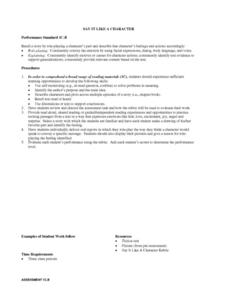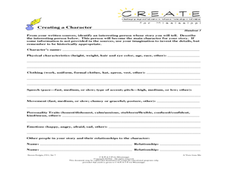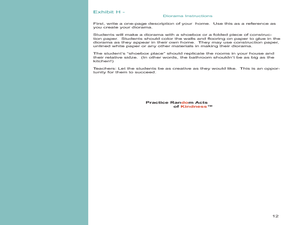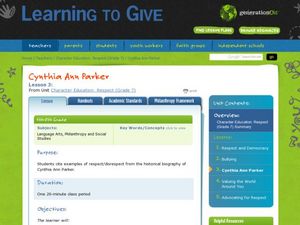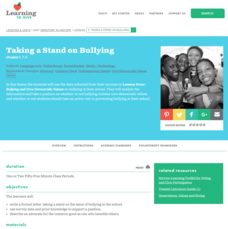Curated OER
How We Feel
Students examine how their feelings make them unique. They read and discuss a poem, develop a list of feelings, and create a drawing of them feeling happy and healthy.
Curated OER
Say It Like A Character
Young scholars read a story and retell it to the class by role-playing one of the characters. In groups, they use the correct facial expressions along with body language and voice to convince the others in their group that they are...
Curated OER
Number The Stars: Characters and Emotions
In this language arts activity, middle schoolers correlate events of a story with an emotion and then write a description of the story details.
Curated OER
CHARACTER DEVELOPMENT: EXAMINE EXPRESSIONS THROUGH PORTRAITURE
Students use a work or art as a springboard to a personal narrative or descriptive writing, create a collage to identify tone through art, and use inference to discern what might have caused an individual to feel the emotion that is...
Curated OER
Creating a Character
For this creating a character worksheet, students identify an interesting person from their written sources. Students will create details to describe their character's physical characteristics, clothing, speech, and personality traits.
Curated OER
Honesty
In this character education worksheet, students review the trait of honesty as they analyze the picture and message depicted on this mini-poster.
Peaceful Solution Character Education
Self-Control Starts With You
How can negative thoughts affect your life? Learn about the ways you think about yourself can define your personality, and how self control can be the answer to higher self esteem.
US Institute of Peace
Identifying Conflicts
When viewpoints collide, conflict arises. Can your pupils identify the components of conflict? The fourth in a series of 15 lessons about peacebuilding helps participants identify the underlying causes of conflict. Teams role play to...
Missouri Department of Elementary
Finding the Positive
To instill the importance of a positive classroom community small groups create a collage out of magazine clippings that highlight three characteristics of self-awareness. Written examples accompany the finished product. Groups turn in...
Orange County Department of Education
Black Cowboy, Wild Horses
Fifth graders read the selection Black Cowboy, Wild Horses and identify characteristics of self-discipline shown by story's main character, Bob Lemmons. Students then identify some of their own traits of self-discipline and reflect upon...
Curated OER
Halloween Literature Unit: Little Critter’s Halloween
Students are read Happy Halloween Little Critter, by Mercer Mayer. In this emotions lesson, students discover how their mood is often affected by their feelings. They discuss the story as a class and then work independently on a...
Curated OER
How to Clean Up An Oil Spill
Students practice cleaning up an oil spill. In this good citizenship lesson, students experiment with different cleaning agents to see which ones clean oil off a soft toy. They compare this experiment with the volunteers helping with the...
Curated OER
Karen Hesse's Witness; Tolerance and Non-Discrimination
Students complete a graphic organizer depicting character views regarding African Americans during the early 20th century in America. In this graphic organizer of views lesson, students read the book Witness and become familiarized with...
Curated OER
Cyberbullying:What is It? What Can We Do About It?
High schoolers examine the prevalence of cyberbullying. In this character education activity, students read articles about cyberbullying and its implications. High schoolers respond to discussion questions.
Curated OER
Rudolph the Red-Nosed Reindeer
Students explore the concept of self-respect. For this character education lesson, students listen to the original "Rudolph, the Red-Nosed Reindeer" story and listen to the song. Students discuss the meaning of the word underdog and the...
Curated OER
Social Studies Strategies Emotional Timeline
In this social studies strategies activity, students record events in a story and chart them on a line graph according to how good or bad they are in the life of the main character.
Curated OER
Character Education: Respect
Second graders design and share care and consideration banner. Students listen to stories about caring and considering others.
Curated OER
Our Successful Traits
Young scholars brainstorm and discuss essential traits for success. They develop a group list that displays essential traits of the successful classroom and journal about the experience.
Curated OER
Taking a Stand on Bullying
Middle schoolers stand up against bullying in a character-building lesson. After discussing historical figures who became advocates in times of adversity, they brainstorm ways to end bullying at their own school, and use a formal letter...
Curated OER
Jewish Heroes Congress
Students explore Jewish heroes throughout history. In this character development and history lesson, students work in groups to research a Jewish hero. A life-size model of the hero is constructed. Students participate in a Jewish Heroes...
Curated OER
Applying Principles of Civic Liberty
Third graders relate the everyday duties in the classroom and in the community. In this character education lesson, 3rd graders compare duties in the classroom to duties in the community and chart them on a Venn diagram. Students discuss...
Curated OER
Dishonesty
Learners explore religion and ethics. In this character education lesson, students compare dishonesty and honesty as they consider the ethics of lying. Learners consider whether certain lies are more acceptable than others and compare...
Curated OER
Passing Notes
Students demonstrate the importance of sharing compliments. In this character education lesson, students write compliments on post-it notes to one of their classmates.
Curated OER
Franklin Says I Love You
Students consider the importance of giving as they read "Franklin Says I Love You". In this character education instructional activity, students engage in discussion about the importance of sharing and giving. They relate to the story by...



